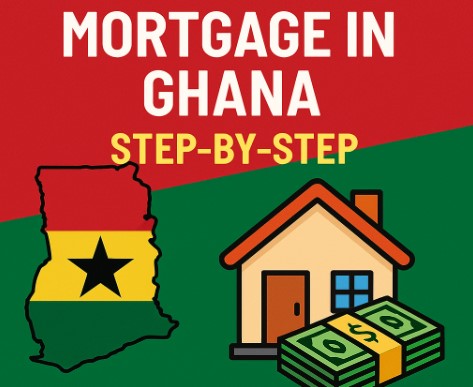
Getting a mortgage in Ghana can be a smart way to finance your dream home or investment property. Here’s a clear step-by-step process you can follow:
Step 1: Check Your Eligibility
Before applying, make sure you meet these basic conditions:
-
Be at least 18 years old (some banks require 21+).
-
Have a steady income (from employment or business).
-
Have a good credit history (especially if applying with banks).
-
Be able to make a minimum down payment (often 10%–30% of the property value).
Banks also prefer applicants who have worked at their current job for at least 2 years.
Step 2: Research Mortgage Providers
In Ghana, you can get a mortgage from:
-
Commercial banks (e.g., Stanbic Bank, Ecobank, Republic Bank, Absa)
-
Specialized mortgage lenders (e.g., Ghana Home Loans)
-
Some real estate developers partner directly with banks for easier financing.
Tip: Compare interest rates, repayment terms, fees, and requirements before choosing.
Step 3: Gather the Required Documents
You’ll typically need:
-
Completed mortgage application form
-
Valid ID (passport, Ghana card, or driver’s license)
-
Recent passport-sized photographs
-
Proof of income (pay slips, employment letter, tax returns if self-employed)
-
Bank statements (last 6 months)
-
Sale agreement or property documents
-
Proof of down payment source
-
Credit report (optional, some banks will check it themselves)
Step 4: Get Pre-Approval (Optional, but Smart)
Some banks offer mortgage pre-approval, meaning they tell you how much you can borrow before you shop for a home.
This helps you:
-
Set a realistic budget
-
Negotiate better with sellers
-
Speed up the final approval process
Step 5: Choose Your Property
Find a property that fits your budget and goals:
-
Residential home
-
Apartment
-
Off-plan property (new developments)
-
Investment property
Important: Make sure the property has a clear title (no legal issues).
You may need a professional valuation done — banks usually require this.
Step 6: Submit the Application
Once you choose a property:
-
Complete the formal mortgage application.
-
Attach all supporting documents.
-
Pay any required application or processing fees.
The bank will review your income, creditworthiness, and property value.
Step 7: Mortgage Offer and Acceptance
If your application is successful:
-
The bank will send you a mortgage offer letter.
-
Review the loan amount, interest rate, repayment period (often 5–20 years), and monthly repayment.
-
Sign and return the acceptance form.
Step 8: Legal Processes and Documentation
The bank’s legal team will:
-
Verify the property documents.
-
Conduct searches at the Lands Commission.
-
Prepare the mortgage deed.
-
Ensure the property is properly registered in your name (with the mortgage recorded).
You will also pay stamp duty (1–3%) and legal fees at this stage.
Step 9: Final Disbursement
After all legal checks:
-
The bank will disburse the loan amount.
-
Funds are usually paid directly to the seller or developer.
-
Your repayment schedule officially starts.
Step 10: Start Repaying
Make your monthly repayments on time!
Missing payments can lead to penalties, or even foreclosure (the bank taking over your property).
Quick Tips for Success
-
Save enough for a solid down payment.
-
Maintain a healthy credit record.
-
Understand all the fees involved (not just interest rate).
-
Plan for property insurance — it’s often mandatory.
-
If you’re living abroad (diaspora), look into special diaspora mortgage options.
Source: thepressradio.com| Ogyem Solomon





